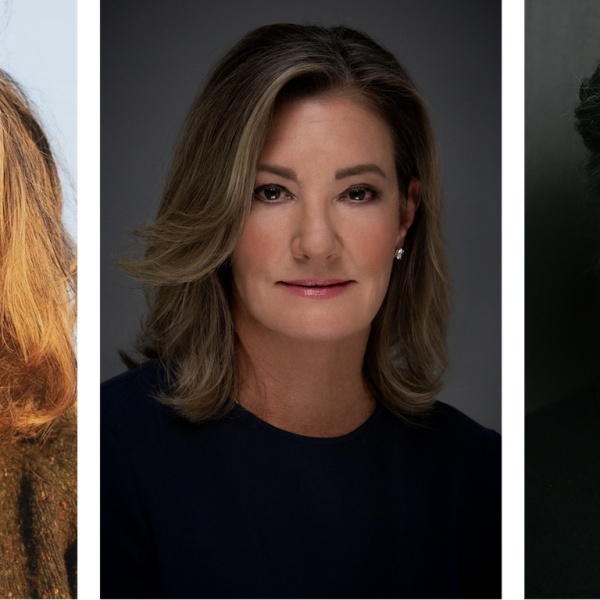How The Weinsteins Messed With ‘Don’t Be Afraid Of The Dark’ & More From The Filmmakers On The Horror Remake

On Monday night, the Film Society Of Lincoln Center hosted a screening of “Don’t Be Afraid of the Dark” as part of their Film Comment Selects series. The Guillermo del Toro-produced horror film is a remake of a 1973 made-for-TV film about a young couple being pursued by malevolent creatures in a spooky old house they’ve inherited. The new version swaps in Guy Pearce and Katie Holmes as interior decorators renovating an old house and gives Pearce’s character an 11-year-old daughter, Bailee Madison (“Brothers”), who ends up the subject of most of the torment.
Del Toro, Holmes and Madison were on hand for a very entertaining Q&A along with director Troy Nixey to discuss the film and its long road to the screen. The project had originally been written by del Toro and co-writer Matthew Robbins (“Dragonslayer”) back in 1998 for Miramax but was shelved after the studio tried to impose countless rewrites to the material, all of which provided plenty of fodder for the conversation. Del Toro did most of the talking and as usual, was incredibly enthusiastic and amiable keeping the audience thoroughly entertained throughout the 45-minute discussion.

1. Miramax put del Toro’s original draft through countless rewrites, but when it finally got made, del Toro went back to the very first draft.
The Weinstein-run Miramax had a legendary run of films in the ’90s, but not without leaving behind more than a handful of strained relationships with various filmmakers whose work they tried to change from the script to the editing. “Don’t Be Afraid of the Dark” was stuck in development hell for over a decade at the studio before being picked back up by del Toro and distributor FilmDistrict.
“This was written in 1998 and they wanted to change it into this and that and I said ‘I’m not doing it,’ so I did ‘Mimic,’ ” del Toro said. Unfortunately this didn’t end up being a great experience for the filmmaker either but he never gave up hope for ‘Dark.’ Miramax had tried to impose many changes to the film, including a note to soften the film’s ending but del Toro wanted the film to stay true to the original film’s bleak denouement. While the studio had wanted the characters running away from a giant explosion, del Toro argued until he eventually got his way. “No no, somebody has to die. Somebody we care for has to die. And it was a big battle. When we shot ‘Mimic,’ the first meeting I had with them I said ‘no explosions, no handguns.’ What do I do? Handguns and explosions after months of torture. But we avoided it [here]. This movie is a horror movie that makes it feel like a gothic thriller in the most traditional way but goes at it in a very non-traditional way.”
“They changed it through the years, they had the creatures giant raping, flying monsters, [and] abducting women into the caverns,” but del Toro insisted on keeping the story simple and when the Weinstein’s left Miramax he went back to the project and scrapped all the revisions. “The draft that we shot is the first draft. There was no reason to change it.”.jpg)
2. Though the film is a remake it bears many of del Toro’s trademarks because he made some very crucial changes to make the story more personal.
“Every story has been told but the why and the when and the who and the whats is what makes them interesting,” said producer/co-writer del Toro. Though the original film scared him silly when he was a kid, when he went back to rewatch the film he found that certain elements didn’t hold up like they had in his memory so he instead decided to write the film from his imagination, sprinkling in distinctly del Toro-ian elements along the way.
“In the first movie the character was a powerless, almost pathologically abused, submissive woman and I hated that idea. [So my idea was] what if by circumstance the girl is really resourceful, really smart, really powerful but she’s 11. Nobody pays attention to her. That changes everything to me,” he explained. “The other thing that was not at all in the other movie was the origin of the creatures being in the dark fairy lore. I’m very influenced by a writer called Arthur Machen that explored the way fairies in pagan mythology are not blinky, shiny little fuckers. They are really nasty, nasty, dirty, ambivalent, malevolent [creatures] and I like that. In Judeo-Christian mythology when God and the Devil were at war the fairy folk declared their neutrality and so they don’t belong to good or bad. They sometimes abduct children, many times abduct them for decades and return them unchanged. There’s really interesting subtext in there.”
Though the film contains many well worn elements (a spooky old house, a young girl who witnesses the supernatural but nobody will believe her), del Toro wasn’t concerned about putting his stamp on them. “The idea for me was making it a fairy tale. I believe fairy tales are the cradle of horror tales, they have many things in common when you analyze gothic fiction.”
3. First time filmmaker Troy Nixey won the Guillermo del Toro lottery.
Nixey spent 17 years working in comics (alongside artists like Mike Mignola, creator of Hellboy) but his first passion was always movies. The first-time director recounts that he realized he just had to start making films if he ever wanted to break into the business so he started with a short film, “Latchkey’s Lament,” which caught del Toro’s attention.
Nixey says, “Early on I’d sent some concept drawings and pictures to Guillermo, to his public email address that he has. And he wrote back and was very encouraging. It took 5 years to finish [the short] and then once it was done, I showed it to Guillermo. And really all I was looking for at the time was, you know, ‘Thumbs up, good job.’ But I got an email through a mutual friend of ours, very encouraging but then our friend phoned back and said ‘well it gets better, he wants to talk to you.’ And he gave me his phone number, I phoned him. He was in prep on ‘Hellboy 2‘ at the time in Budapest. I called him and he said, ‘Yep, yep great. Really enjoyed it, this that and the other thing. I have this script that I wrote and I’m not going to direct it. Would you be interested in reading it?’ “
Nixey said the film combined all of his favorite things and worked on the concept art alongside del Toro, who he called “his favorite filmmaker.”
4. Though del Toro was passionate about resurrecting the project he knew that he couldn’t direct it because of some similarities to his previous work.
Del Toro said, “I wrote it in 1998 and in the interim, I did ‘Pan’s Labyrinth‘ and superficially felt they shared a girl arriving to a new house, discovering a secret place and I felt ‘Nope, I’m not doing that.’ I really felt it needed another voice and I really enjoy producing horror more than directing horror. The movies I do, I try to do counter to a lot of things even if they’re generically action or horror. And I thought this needs to work really really like a horror film and I loved producing ‘The Orphanage‘ or this cause I get the experience of seeing the audience jump but don’t have to go through the exercise of doing the horror movie without experimenting with really weird stuff. I like going to weird places with the movies I do.”
Asked why he frequently features a young protaganist the Mexican filmmaker said, “For me the seed of horror was childhood. As a kid I was absolutely terrified of everything. I was 17 years old at age 7 and now I’m 46 and I’m 7 years old in my heart.”
5. Del Toro credits FilmDistrict for backing the R-rating all the way.
Del Toro was proud that despite having no intense gore or brutality the film received an R rating simply for being too intense. “I actually like that. Thankfully we have Bob Berney at FilmDistrict saying ‘Let’s do it as an R.’ Most other distributors would say ‘Let’s cut it, let’s go back to the PG-13’ but [they didn’t.] Everybody praises always how brave filmmakers are but what’s great is when distributors are brave…I think this movie mutilated into a PG-13 would be a shame. It’s not overt, it’s not gory, it has every right to be scary. And I think we need to make like, the scary pride parade and say ‘We want to be super scary and we don’t have to be ashamed of it.’ PG-13 is the refuge of many cowards.”
6. Del Toro likes doing projects that straddle different genres but isn’t keen on trying to make a horror-comedy.
During the film there are several intense moments where the audience erupted in some laughter so del Toro was asked about these moments and whether or not they were intentionally funny. He said, “I think you have to have release. What I don’t like personally is to write humorous horror set pieces that combine straight horror with comedy. Some people do it brilliantly like John Landis, Joe Dante but I don’t write it like that. What I think is important is to have some moments where you [get a] release through laughter. Like when she crushes a creature, it’s like ‘Yeah!’ and you laugh because it reminds you of how small they are.”
Filmlinc has also posted the full conversation which you can check out below:


